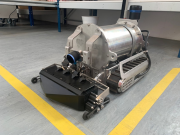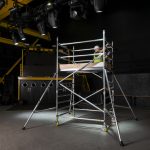Electrocomponents is helping to revolutionise the way periodic inspections of petrochemical storage tanks are carried out in order to reduce the hazards, environmental impact, and costs associated with this global industry.
Project nautilUS is a UK-based consortium championed by several leading global companies and institutions, which have been working together since February 2018 to design and develop a multi-million-pound certified non-destructive testing (NDT) solution. Co-funded by Innovate UK, the consortium also includes InnoTecUK, London South Bank University, Sonomatic, and TWI. Electrocomponents has developed the Quality Functional Deployment (QFD) model via RS Monition, the company’s maintenance engineering specialist service, and its DesignSpark engineering platform and community continues to create vital opportunities for intellectual property development and commercialisation of the technology.
Oil and fuel storage require a robust and reliable infrastructure, with regular inspection critical to ensure that tanks are fit for purpose. Existing inspection methods often result in storage tanks being taken out of service to be drained and inspected for corrosion, which is hazardous, time-consuming and costly work.
The nautilUS solution addresses these issues head-on, in the form of a small robot which can monitor and plot its own position whilst carrying out corrosion inspection. The robot uses active real-time remote controls to move around a tank, and an ultrasound probe to take measurements of floor thinning. It then records data regarding location for post-processing after the robot is retrieved. The design aims to obtain the smallest possible footprint to allow entry via the smallest manholes of liquid storage tanks. For the robot to perform an inspection in an explosive and flammable environment, the robot operation must avoid sparking, which can create an explosion in the tank due to heat and the presence of vapour. As well as offering ease of use and unique movement capabilities, the technology can also be applied to the inspection of ship-borne fuel tanks, transportation tanks and water storage tanks.
Michael Burrows, Senior Innovation Advisor at Electrocomponents, said: “As well as our responsibilities around IP and commercialisation for nautilUS, we carried out a very extensive piece of work, called a Quality Functional Deployment (QFD) model ahead of the project, where we went out to over 100 current users and tank farm operators to uncover their list of requirements. We needed to know what the must-haves were and the nice-to-haves. This helped to shape the ergonomics, the ease of use, the size, the deployment, and the ability to deploy with limited people.
“We have received a very high level of interest already. There are 600 tank farm operators globally and we’ve already got an active response from around 70 of them with a number of offers to utilise the technology in their tanks.
“Within the oil and gas industry there is an overarching goal to make it unmanned by 2030. Part of the commercialisation that we have been involved with has been to generate interest in not only the overall nautilUS robot, but also the technologies within it. Of course, we have the robot in its entirety, but there are also opportunities to license the individual pieces of technology for existing solutions or other applications.”
The DesignSpark engineering platform has been part of the multidisciplinary team throughout the project and a variety of articles and videos outlining progress are available at: https://www.rs-online.com/designspark/project-nautilus-revolutionising-petrochemical-oil-tank-inspections and https://www.rs-online.com/designspark/project-nautilus-member-innotecuk
To watch the video of the first in-oil tank test, visit: https://www.rs-online.com/designspark/nautilus-the-answer-to-low-cost-oil-tank-inspection







